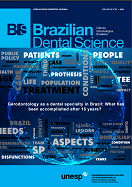Endocrown: a conservative approach
DOI:
https://doi.org/10.14295/bds.2016.v19i2.1156Resumo
ABSTRACT
The purpose of this clinical case description article was to present the planning sequence, indication, treatment and performance to obtain a crown of the Endocrown type. This clinical case description article illustrates a therapeutic option for functional and esthetic rehabilitation of a devitalized mandibular molar, presenting a small amount of remaining coronal tooth structure, by means of cementing a pure porcelain crown of the Endocrown type (Adhesive Endodontic Crown). A 39-year-old woman presented to the Graduate clinic of the Bauru Dental School (FOB), University of São Paulo (USP), with the complaint that tooth #36 had an extensive and unsatisfactory composite resin restoration. The lithium disilicate-based system of monolithic porcelain was used with the lost wax technique. This therapy promoted the stability and retention of the indirect restoration, without the need for performing reconstruction of the above mentioned tooth, either by means of a cast metal core or reconstruction with intracanal post, thereby reducing the treatment time. After the tooth preparation, the provisional restoration was done with acrylic resin to determine if the retention and stability of the remaining tooth was adequate to receive the indirect Endocrown restoration. The characteristics of the internal and external walls of the dental remnants, cervical termination, impression-taking, laboratory stages and adhesive cementation will be discussed. The major advantage of indicating an endocrown is the use of the dental remnants itself, particularly the pulp chamber, to promote retention and stability in cases without adequate height for performing complete dental and crown reconstruction.
Keywords
Adhesive endodontic crown; Devitalized tooth; Lithium dissilicate.
Downloads
Downloads
Arquivos adicionais
Publicado
Como Citar
Edição
Seção
Licença
TRANSFERÊNCIA DE DIREITOS AUTORAIS E DECLARAÇÃO DE RESPONSABILIDADE
Toda a propriedade de direitos autorais do artigo "____________________________________________________________________" é transferido do autor(es) para a CIÊNCIA ODONTOLÓGICA BRASILEIRA, no caso do trabalho ser publicado. O artigo não foi publicado em outro lugar e não foi submetido simultaneamente para publicação em outra revista.
Vimos por meio deste, atestar que trabalho é original e não apresenta dados manipulados, fraude ou plágio. Fizemos contribuição científica significativa para o estudo e estamos cientes dos dados apresentados e de acordo com a versão final do artigo. Assumimos total responsabilidade pelos aspectos éticos do estudo.
Este texto deve ser impresso e assinado por todos os autores. A versão digitalizada deverá ser apresentada como arquivo suplementar durante o processo de submissão.




























